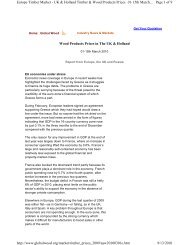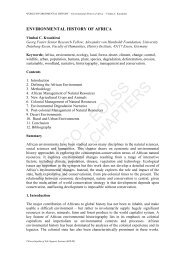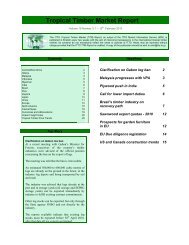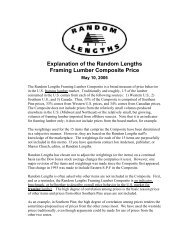ICT and e-Business in the Pulp, Paper and Paper ... - empirica
ICT and e-Business in the Pulp, Paper and Paper ... - empirica
ICT and e-Business in the Pulp, Paper and Paper ... - empirica
Create successful ePaper yourself
Turn your PDF publications into a flip-book with our unique Google optimized e-Paper software.
<strong>Pulp</strong>, paper <strong>and</strong> paper products<br />
Exhibit 3-29: Companies receiv<strong>in</strong>g orders from customers onl<strong>in</strong>e<br />
Accept orders<br />
from<br />
customers<br />
onl<strong>in</strong>e<br />
Receive 1-25%<br />
of orders<br />
onl<strong>in</strong>e<br />
Receive more<br />
than 25% of<br />
orders onl<strong>in</strong>e<br />
Use specific<br />
<strong>ICT</strong> solutions<br />
for e-sell<strong>in</strong>g<br />
Weight<strong>in</strong>g scheme:<br />
% of % of % of % of % of % of % of % of<br />
empl. firms empl. firms empl. firms empl. firms<br />
<strong>Pulp</strong> & <strong>Paper</strong> (EU-10) 26 28 78 77 22 23 19 11<br />
Micro (1-9 empl.) 30 75 25 9<br />
Small (10-49 empl.) 26 80 20 12<br />
Medium (50-249 empl.) 24 77 23 15<br />
Large (250+ empl.) 26 84 16 24<br />
NACE 21.1 (p&p man.) 18 19 77 81 23 19 20 14<br />
NACE 21.2 (convert<strong>in</strong>g) 29 31 78 73 22 27 18 11<br />
All 10 sectors (EU-10) 35 25 73 75 27 25 18 9<br />
Micro (1-9 empl.) 23 79 21 6<br />
Small (10-49 empl.) 26 76 24 12<br />
Medium (50-249 empl.) 29 75 25 16<br />
Large (250+ empl.) 26 74 26 27<br />
Base (100%)<br />
firms us<strong>in</strong>g<br />
computers<br />
firms accept<strong>in</strong>g<br />
orders onl<strong>in</strong>e<br />
firms accept<strong>in</strong>g<br />
orders onl<strong>in</strong>e<br />
firms us<strong>in</strong>g<br />
computers<br />
N (for sector, EU-10) 964 271 271 964<br />
Questionnaire reference F4 F6 F6 F10<br />
* Data are not displayed because <strong>the</strong> number of observations <strong>in</strong> <strong>in</strong>dividual countries is too low for this <strong>in</strong>dicator.<br />
** Data only <strong>in</strong>dicative due to low number of observations (N ~ 25-50).<br />
Source: e-<strong>Bus<strong>in</strong>ess</strong> W@tch (Survey 2006)<br />
As <strong>in</strong> 2005, e-<strong>Bus<strong>in</strong>ess</strong> W@tch asked companies whe<strong>the</strong>r <strong>the</strong>y "support market<strong>in</strong>g <strong>and</strong><br />
sales processes by specific <strong>ICT</strong> solutions." The rationale for this question is to fur<strong>the</strong>r test<br />
to what extent <strong>the</strong>ir e-commerce activities are digitally <strong>in</strong>tegrated processes, or whe<strong>the</strong>r<br />
<strong>the</strong>y use ra<strong>the</strong>r "simple" forms of e-commerce, such as receiv<strong>in</strong>g orders by e-mail without<br />
any system <strong>in</strong>tegration of <strong>the</strong> related <strong>in</strong>formation <strong>and</strong> document flow.<br />
In <strong>the</strong> P&P <strong>in</strong>dustry, more than 10% of firms (represent<strong>in</strong>g close to 20% of sector<br />
employment) reported <strong>the</strong> use of software solutions or <strong>in</strong>ternet-based services for <strong>the</strong>ir<br />
market<strong>in</strong>g <strong>and</strong> sales activities (see Exhibit 3-29). This shows that, <strong>in</strong> fact, <strong>the</strong>re is a<br />
considerable gap between <strong>the</strong> percentage of companies receiv<strong>in</strong>g at least some orders<br />
onl<strong>in</strong>e (~30%) <strong>and</strong> those that have special software for do<strong>in</strong>g so (~10%). The percentage<br />
is much closer to <strong>the</strong> one for ERP adoption (16%). In essence, <strong>the</strong> systematic management<br />
of onl<strong>in</strong>e orders will <strong>in</strong> many cases be conducted via <strong>the</strong> ERP system of a company.<br />
Those companies which have specific sales systems <strong>in</strong> place tend to use <strong>the</strong>m ma<strong>in</strong>ly for<br />
<strong>the</strong> core functions of publish<strong>in</strong>g offers to customers (62%), for enabl<strong>in</strong>g customers to<br />
place orders (74%) <strong>and</strong> also for answer<strong>in</strong>g calls for tender (57%). Only one <strong>in</strong> five<br />
companies with such systems also enable customers to actually pay onl<strong>in</strong>e for <strong>the</strong> goods<br />
which <strong>the</strong>y have ordered. The latter <strong>in</strong>cidence shows how important it is to make a<br />
difference between <strong>the</strong> various phases <strong>in</strong> e-commerce transactions when analys<strong>in</strong>g this<br />
topic. Enabl<strong>in</strong>g customers to place an onl<strong>in</strong>e order is <strong>in</strong> many cases still separated from<br />
74

















